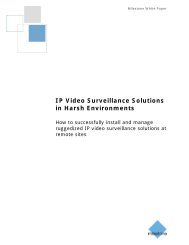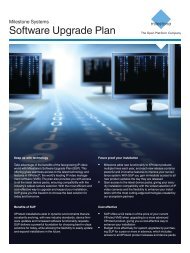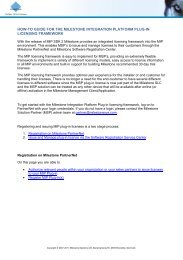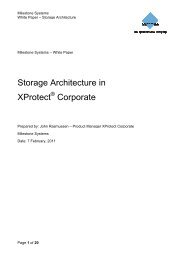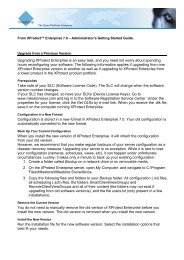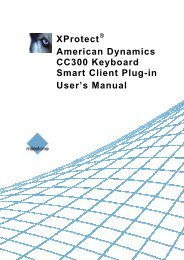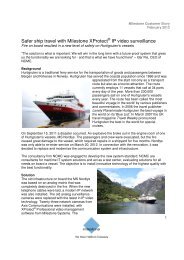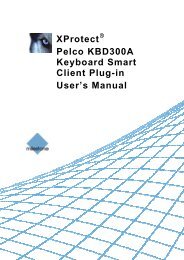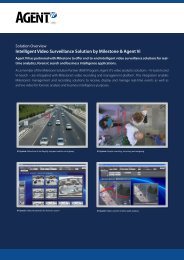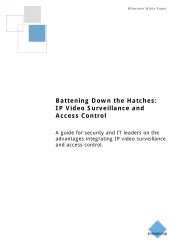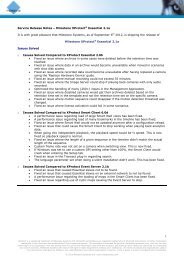XProtect Express 1.1; Administrator's Manual - Milestone
XProtect Express 1.1; Administrator's Manual - Milestone
XProtect Express 1.1; Administrator's Manual - Milestone
Create successful ePaper yourself
Turn your PDF publications into a flip-book with our unique Google optimized e-Paper software.
<strong>Milestone</strong> <strong>XProtect</strong> ® <strong>Express</strong> <strong>1.1</strong><strong>Administrator's</strong> <strong>Manual</strong>About archiving to other locationsWhen you archive to other locations than the default archiving directory, <strong>XProtect</strong> <strong>Express</strong> will first temporarilystore the archive in the local default archiving directory, then immediately move the archive to the archivinglocation you have specified.Archiving directly to a network drive can mean that archiving time varies depending on the available bandwidth onthe network. First storing the archive locally, then moving it speeds up the archiving procedure, and reducesdelays in case of network problems.If you archive to a network drive, the regular camera database can only be stored on a local drive attacheddirectly to the <strong>XProtect</strong> <strong>Express</strong> server.About dynamic archive pathsWith dynamic archiving paths, you specify a number of different archiving paths, usually across several drives.Using dynamic paths is recommended and is the default setting when you configure cameras through theConfigure video & recording wizard (see "About video and recording configuration" on page 75).If the path containing the camera's database is on one of the drives you have selected for dynamic archiving,<strong>XProtect</strong> <strong>Express</strong> will always try to archive to that drive first. If not, <strong>XProtect</strong> <strong>Express</strong> automatically archives to thearchiving drive with the most available space at any time, provided a camera database is not using that drive.The drive that has the most available space may change during the archiving process, and archiving maytherefore happen to several archiving drives during the same process. This will have no impact on how users findand view archived recordings.Dynamic archiving paths are general for all your cameras; you cannot configure dynamic archiving paths forindividual cameras.When deciding which drives to use for dynamic archiving, consider the pros and cons in the following examples(in which we assume that the default archiving path (see "Configure default file paths" on page 166) is on driveC:—drive letters are examples only, different drive letters may of course be used in your organization): Camera records to drive C: and archives to drive C:If the path containing the camera's database is on one of the drives you have selected for dynamicarchiving, <strong>XProtect</strong> <strong>Express</strong> will always try to archive to that drive first. Archiving will take place quickly,but may also fill up the drive with data fairly quickly. Camera records to drive C: and archives to drive D:Recordings and archives are on separate drives. Archiving takes place less quickly. <strong>XProtect</strong> <strong>Express</strong> willfirst temporarily store the archive in the local default archiving directory on C:, then immediately move thearchive to the archiving location on D:. Therefore, sufficient space to accommodate the temporaryarchive is required on C:.Camera 1 records to drive C: and archives to drive D: while Camera 2 records to drive D: andarchives to drive C:Avoid this. One camera's archiving may take up space required for another camera's recordings. In theabove example, Camera 1's archiving to D: may result in no recording space for camera 2 on D:. The ruleis: "Do not cross recording and archiving drives."•About archiving audioIf an audio source (for example, a microphone) is enabled on a hardware device, audio recordings are archivedtogether with video recordings from the camera attached to the hardware device. If the hardware device is a videoencoder with several channels, audio is archived with the camera on channel 1.When an audio source is enabled, audio is recorded to the associated camera’s database. This will affect thedatabase’s capacity for storing video. You may, therefore, want to use scheduled archiving more frequently ifrecording audio and video than if only recording video.www.milestonesys.com 120 Advanced configuration



